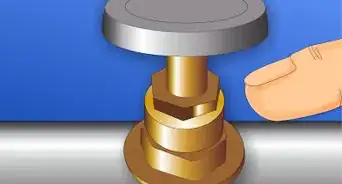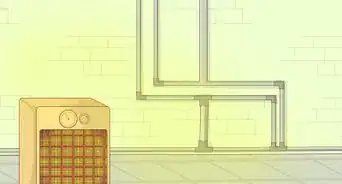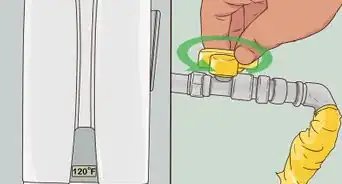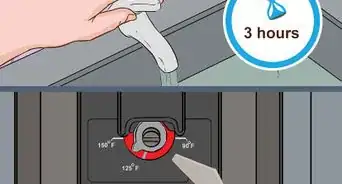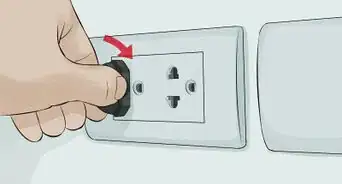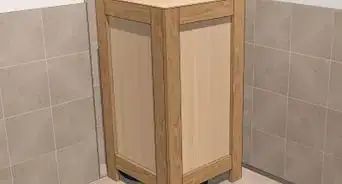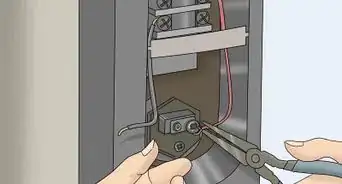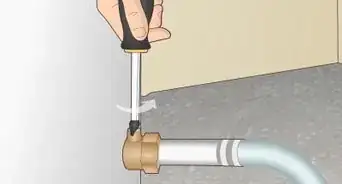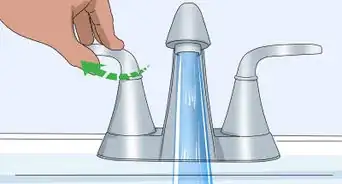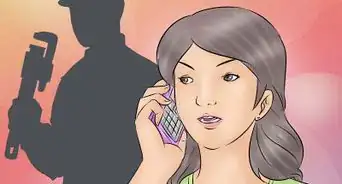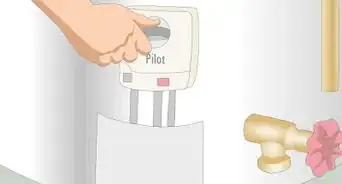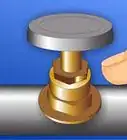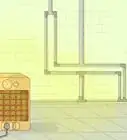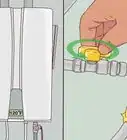This article was co-authored by Patrick Johns. Patrick Johns is a Home Improvement Specialist and the Owner of CatchAll Handyman Services. With more than 28 years of experience, he has worked on a variety of home improvement projects, such as carpentry, plumbing, and door and window installations in both commercial and residential properties.
wikiHow marks an article as reader-approved once it receives enough positive feedback. This article received 21 testimonials and 100% of readers who voted found it helpful, earning it our reader-approved status.
This article has been viewed 1,061,855 times.
Water heaters should be flushed every one to three years depending on the model and water source. This helps to control the buildup of mineral deposits. Your water heater will operate more efficiently and this will usually extend the life of the heater. Use this guide to flush your water heater.
Steps
Flushing the Heater
-
1Locate the breaker/fuse box for an electrical heater or the thermostat for a gas heater. Before you begin draining your water heater, you will first need to find the main power source and turn it off.
- The breaker box or fuse box is usually a small, grey power panel (about the size of a shoebox) with a swinging door. It is often attached to a wall. In some homes, it is located in the garage and in others it can be on the outside of the house.
- The thermostat for the gas heater is usually a red knob located on the outside of the heater where the gas pipe enters the unit. The knob should have 3 settings: "Pilot," "On," and "Off."
-
2Disable the circuit or fuse that powers the electrical water heater, or turn the thermostat to "Pilot" on a gas heater. This will cease power to the water heater or the entire house, depending on which circuit/fuse you disable.
- You should see small on/off switches. These are called "branch circuits breakers," and they provide protection against electrical overload to different circuits powering your house. If you know which branch circuit breaker is powering your water heater, turn this individual switch off.
- If you don't know which individual circuit breaker is powering your heater, locate a larger switch labeled "Main" above the branch circuit breakers. The main circuit breaker should have higher amperage values like 100, 150, or 200. The branch circuit breakers will have lower numbers from 10-60amps. Turn the main power off, but know that all the power to your house will be shut off for the time-being.
- If you open the box and find round, glass topped shapes or small tubes with metal ends, you have a fuse box, not a breaker box. In this case, you will need to unscrew and remove the fuse that is powering your water heater (similar to turning off the branch circuit breaker). If you are unsure of which fuse to remove, look for a large rectangular box with a handle/lever at the top of the panel. Tug hard and straight out on the handle, but be careful because the metal parts may be hot.[1] The power to your entire house has now been shut off.
Advertisement -
3Turn off your cold water supply by rotating the water shut-off valve clockwise. The shut-off valve should be located at or near the cold water inlet pipe at the top of the tank.
- There are two types of valves in use: ball valves and gate valves. A 90-degree turn closes and opens the ball valve, but a gate valve takes many turns.
- Some gate valves have a "stop" before they are fully closed or open, so be sure you turn the valve past that stop. Gas and propane supply valves for non-electric heaters can be left on.
- For natural gas and propane (LP) water heaters, make a note of what the temperature setting is and then turn the thermostat, the large red dial on the front of the control, to the lowest setting, or "Pilot."
- If you plan to use the water for other purposes, turn the heat off ahead of time and allow the water to cool overnight before draining.
-
4Open the hot water faucet in your sink or tub. This will prevent a vacuum from forming in the lines keeping water trapped. [2]
- A similar example of this is when you cover the top of a straw to retain water.
- A similar example of this is when you cover the top of a straw to retain water.
-
5Attach a garden hose to the drain cock, or valve, located at the bottom of the heater. The drain cock usually looks like a regular hose bib, such as a garden faucet, or a round dial with a threaded hole in the middle.
- The drain cock may be hidden under a removable cover.
- If you don't have a garden hose, you can use a bucket to catch the water and dump it somewhere safe manually. Don't overfill the bucket since the hot water can soften cheaper plastic buckets or can burn you.[3]
-
6Extend the garden hose to a place where the water from the heater can safely discharge. Either run your hose to an outside drain or to your driveway.
- If you allowed the water to cool overnight, you can drain it into buckets and save the water to use on the yard or for other purposes. Don't use it for delicate plants, though, or to wash your car, given the presence of sediment.
- If draining hot water, also be careful of the materials you use. Low-quality hoses and buckets may soften due to the heat, causing leaks. To simplify the process, drain straight into a suitable basement drain or sump hole.
- Cover the drain cock and hose connection with a towel or rag to prevent scorching water from bursting and spraying in case there is a pressure leak especially if the water heater supplies a second floor or if located in a basement.
-
7Open the drain cock to allow the water to exit the heater. Consider opening the pressure-relief valve, usually on the top of the unit, to allow water to flow freely. But DO NOT open the pressure-relief valve without first placing a bucket under the discharge pipe. Opening it can allow water to drain onto the floor unless something is placed under the discharge pipe to catch the water.
- The pressure relief valve is usually a lever that you flip into an "up" position to open it.
- Make sure water flows at a rate that wherever you are draining to can be managed.
- Caution: If you did not allow the water to cool, it will be extremely hot as it leaves the tank. Also, realize that if the drain cock is made of plastic and the heater is several years old, it may be difficult to open and may break if forced.
-
8Fill a "test" bucket with the still flushing water after a few minutes of flushing. Allow the water in the bucket to stand undisturbed for a minute and see if the water is clear or if any sand-like material settles to the bottom.
- If the water is cloudy or you see sand-like material on the bottom of the bucket, continue draining the tank until the water is clear (free of sediment or discoloration). If the tank is empty but you suspect sediment remains, turn the cold-water supply back on to allow more water into the unit. Fill the tank partially and then drain it again. Repeat this process until the discharge is clear.
- If the water is clear and you see no sediment , you may carry on to the next step.
Finishing Up
-
1Close the drain cock and remove the garden hose. Close the pressure-relief valve if opened.
- Also remember to turn off the hot water faucet in your sink or tub.
-
2Turn the water supply back on and let the tank fill. When the tank is full and the pressure has equalized, slowly reopen the pressure-relief valve to bleed off the excess air.
- This will keep the water heater from "pinging" as cold water re-enters it during normal use. After all the compressed air has escaped, close the pressure-relief valve again.
-
3Close the water heater drain. Open the hot water tap in the bathroom to bleed air.
- Do not turn on the power yet. If you turn the power on without filling, the heating element can be damaged. Open the hot water tap on the bathtub or wash basin and wait for a full stream of water.
-
4Turn the water supply back on and wait until the hot water line begins running continuously. After the hot water tap is running at full volume, it is safe to turn on the circuit breaker or fuse box.
-
5Turn off the tub spigot. Wait for about 20 minutes and then test for hot water at the bathtub.
- Listen carefully to the water heater to determine if it is working.
Community Q&A
-
QuestionAre any additives such as distilled vinegar ever used in the flushing/draining process?
 Community AnswerAcid is used but it is a professional task and the acid used will depend on the construction of the heater.
Community AnswerAcid is used but it is a professional task and the acid used will depend on the construction of the heater. -
QuestionCan I turn off the cold water valve at the tank and take a shower to drain some of the hot water from the tank before I attach the hose to the drain valve? I just hate to waste all that hot water drown the drain!
 Community AnswerThat will not work. When you turn off the cold water valve at the top, then no hot water will flow. The best bet is to turn off the heater (gas or electric) and take a shower. The water will slowly get colder as the hot water is used up and replaced by cold.
Community AnswerThat will not work. When you turn off the cold water valve at the top, then no hot water will flow. The best bet is to turn off the heater (gas or electric) and take a shower. The water will slowly get colder as the hot water is used up and replaced by cold. -
QuestionWhat do I do if the water is hot, but gets cold after a few minutes?
 Community AnswerThere are many things it could possibly be. 90% of the time, one of the elements have to be replaced (normally the lower one). Then there is the thermostat, the dip tube, sediment, etc.
Community AnswerThere are many things it could possibly be. 90% of the time, one of the elements have to be replaced (normally the lower one). Then there is the thermostat, the dip tube, sediment, etc.
Warnings
- Be careful, as the water may be very hot.⧼thumbs_response⧽
- Do not power on without filling with water completely. If you do, the heating element will be damaged.⧼thumbs_response⧽
- Be careful not to break the drain cock.⧼thumbs_response⧽
- Regular flushing will keep your heater free of debris, but most plumbers caution that if the valve hasn't been opened in more than five years, it may be best not to attempt turning the handle as the valve may fail.⧼thumbs_response⧽
- If you do not feel comfortable doing this work yourself, call a licensed plumber.⧼thumbs_response⧽
- Do not turn off the pilot or gas to the water heater just turn it to the lowest setting. This way you do not have to go through the relighting procedures; you will just have to turn up the gas control valve⧼thumbs_response⧽
Things You'll Need
- Durable garden hose.
- Durable large bucket.
- Suitable draining area.
a pair of gloves
References
About This Article
To flush a water heater, start by turning off the heater's power source using the breaker or thermostat. Next, rotate the water shut-off valve on your heater clockwise to turn off the cold water supply. Then, turn on a hot water faucet in one of your sinks or tubs to prevent a vacuum from forming in the lines. Once you've done that, attach a garden hose to the drain valve on the bottom of your heater and run it outside or into a bucket. Finally, open the drain valve to drain the water out of the heater. To learn how to get your heater back up and running when you're done, scroll down!

